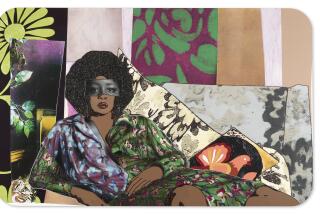La Cienega Area
- Share via
Sweeping simplicity of line gives Basil Langton’s female nude figures classic grace and delicacy. This quality also subtly restructures modern notions about ideal feminine beauty. The artist all but obliterates magazine advertisements that glorify the modern woman. He hand-washes the inks from the page with solvent, leaving only swirling grounds of color and patches of the original image. The fragments--an eye, face, hand or part of a leg--are then made into a more reserved and romanticized image of woman as the artist quickly outlines a more classic face or figure over the original.
Rounded nudes done in swift line have the free, generalized purity of drawings by Henri Matisse. But some, like “Portrait,” also recall Picasso’s primitivist Cubism. In the intriguing “Time,” the viewer can still see the faded original advertisement underlying the newer image. The superimposition of one “message” onto another creates a kind of visual dialogue about ideals of the past and present. In “Debutante,” this mingling of past and present addresses the classic femininity of the “Three Graces” who seem to emerge from behind the jewelry and glitz of contemporary fashion, thanks to Langton’s fragmentary photo editing.
More than a blanket conceptual rejection of the contemporary independent woman or a nostalgic call for pre-feminist ideologies, Langton’s nudes read like a search for an expression of timeless beauty and perfection. Yet most of the figures have a gentle naturalness that transforms their origin as sales hype. (Gallery 454 North, 454 N. Robertson Blvd., to Sept. 3.)
More to Read
The biggest entertainment stories
Get our big stories about Hollywood, film, television, music, arts, culture and more right in your inbox as soon as they publish.
You may occasionally receive promotional content from the Los Angeles Times.










